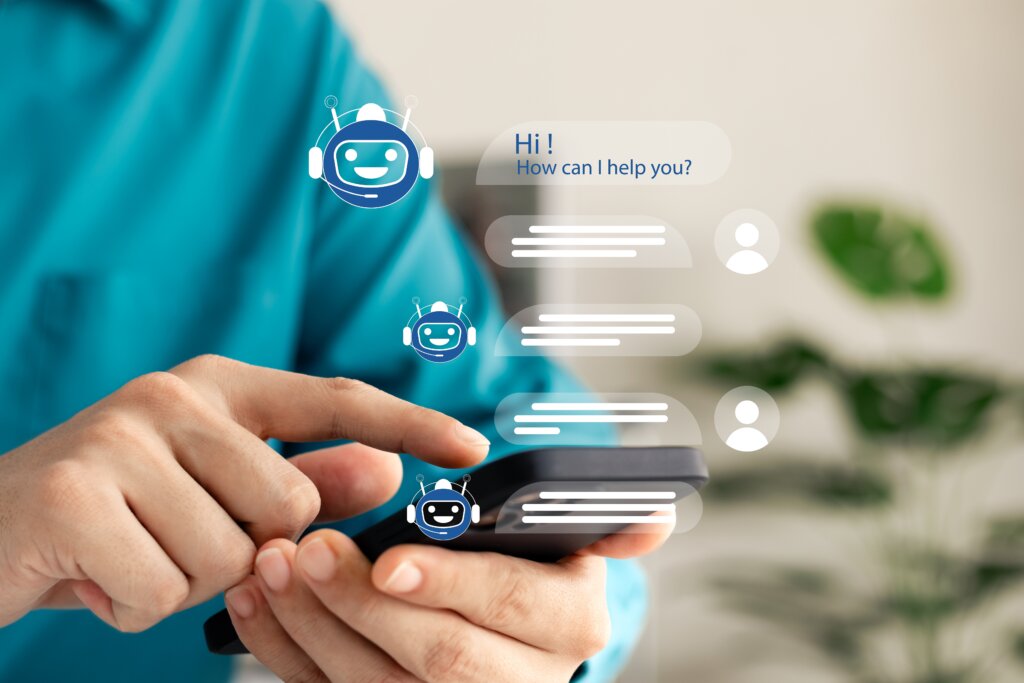The use of chatbots in digital customer service and engagement has become increasingly popular in recent years. These computer programs, which can simulate conversations with human users, have the potential to revolutionize the way businesses interact with customers.
In this blog post, we will investigate the role of chatbots in digital customer service and engagement, including their benefits, potential downsides, and best practices for implementation. We will also look at how businesses currently use chatbots and how they can improve customer engagement and satisfaction.
So, let’s dive in and discover how chatbots can help your company deliver a better customer experience.

The importance of digital customer service and engagement
Digital customer service and engagement are essential for any business looking to connect with its customers in today’s digital age. With the rise of e-commerce and online interactions, customers now expect to be able to reach out to a business at any time, on any device, and receive a quick and personalized response.
A strong digital customer service and engagement strategy help to improve customer satisfaction and loyalty and can drive sales and increase brand awareness. With the high volume of customer interactions that businesses now receive, chatbots have become a popular tool for automating and streamlining customer service and engagement processes, allowing companies to scale their support efforts and improve efficiency.
Learning about Chatbots
Understanding chatbots and their capabilities is an important step in deciding whether or not to incorporate them into your digital customer service and engagement strategy.
Chatbots are computer programs developed to simulate conversation with human users. They can automate many customer service tasks, such as responding to frequently asked questions, providing product or service information, and even handling simple transactions. You can integrate them into websites, mobile apps, and messaging platforms.
They are becoming increasingly popular as they can provide 24/7 customer service, handle multiple customer interactions simultaneously, and can be quickly programmed with new information.
Definition and types of chatbots
A chatbot is a computer program designed to simulate conversation with human users. They can be found in various forms, such as virtual assistants on mobile devices, messaging apps, or websites.
There are several types of chatbots, including rule-based chatbots, which follow a set of pre-programmed rules to answer user queries, and AI-based chatbots, which use artificial intelligence and natural language processing to understand and respond to user inputs.
Another type is a hybrid chatbot, a mix of rule-based and AI-based chatbots. They can be more sophisticated and accurate in their responses.
Benefits of chatbots for customer service and engagement
Chatbots offer a variety of benefits for customer service and engagement, including:
Automation – Chatbots can automate many tedious tasks associated with customer service, such as answering frequently asked questions. This frees up time for employees to focus on more complex customer requests.
Cost Savings – Chatbots can reduce costs by automating customer service tasks, eliminating the need for additional personnel.
24/7 Availability – Chatbots can provide 24/7 customer service, allowing customers to get answers to their queries anytime.
Data Collection – Chatbots can collect data from customer interactions, which You can then use to improve customer experience and satisfaction.
Designing a chatbot strategy
Several key factors must be considered when designing a chatbot strategy to create a successful and effective one.
First, it is important to understand your business’s specific needs and goals and how a chatbot can help meet them. This includes understanding the types of customer interactions and questions the chatbot will handle and identifying the functions and features that the chatbot will need.
Next, choosing the right platform and technology for your chatbot is important.
Many different options are available, including cloud-based, on-premise, and hybrid solutions, each with its advantages and disadvantages. Additionally, it is important to consider the different types of chatbots, such as rule-based, AI-based, and hybrid chatbots, and choose the one that best fits your needs.
Once the chatbot strategy has been defined, it is important to design and test the chatbot to assure that it meets the needs of your business and provides an optimal user experience. This includes preparing the chatbot’s user interface and the conversation flow, as well as testing the chatbot’s functionality and performance.
Finally, it is important to continuously monitor and analyze the chatbot’s performance and make adjustments as needed to improve its effectiveness and meet the needs of your business and customers. This may include analyzing metrics such as customer satisfaction and conversion rates and updating the chatbot’s functionality and features.
Creating a chatbot flow and script
The flow and script refer to how the chatbot interacts with the user and the messages it displays. It’s important to have a clear and logical flow to ensure the user’s experience is smooth and efficient.
The script should be well-written, providing relevant information and guiding the user towards their goal. This could include a welcome message, options for the user, and responses to common questions or concerns. It’s also important to have a way for the user to contact a human representative if needed.
Crafting an efficient flow and structured dialogue can lead to a successful chatbot that provides excellent customer service for your business.
Implementing and managing your chatbot
Integrating a chatbot into your customer service and engagement plans requires syncing it to your website or mobile app and configuring the relevant tools for tracking and managing its performance.
This includes selecting a chatbot platform and connecting it to your customer service and engagement tools, such as CRM software and helpdesk systems.
Once your chatbot is set up, it’s important to monitor its performance and make adjustments continuously, such as updating the script or flow and training the chatbot on new responses. This will ensure that your chatbot provides the best possible customer service and engagement for your users.
Training your chatbot to understand natural language and respond to customer queries
When creating a chatbot flow and script, it’s important to remember the natural language and queries that customers may use. To train your chatbot to understand and respond to these, you can use a combination of pre-defined responses and machine learning algorithms.
Pre-defined responses can be created by anticipating the most common questions and concerns that customers may have. At the same time, machine learning algorithms can train the chatbot to understand and respond to a wider range of languages and queries. This will ensure that your chatbot can provide accurate and helpful responses to customers, improving their overall experience with your brand.
Measuring and analyzing the performance of your chatbot
After your chatbot is up and running, it’s essential to measure and analyze its performance. This involves tracking how many users interact with the chatbot, what type of conversations they are having, and how satisfied they are with the responses. You can use analytics tools to track these metrics and compare them to the performance of other customer service and engagement tools.
Analyzing your chatbot’s performance will enable you to identify areas for improvement, such as updating the script or flow, adding new features, or training the chatbot on more responses. This will ensure that your chatbot provides your users with the best possible customer service and engagement.
You can improve customer service and engagement for your brand by properly implementing and managing your chatbot. With careful monitoring and analysis of its performance, you can ensure that your chatbot provides accurate and helpful responses to customers, improving their overall experience with your brand.
Best practices and case studies
By studying best practices and analyzing case studies, you can gain valuable insights into deploying and managing a chatbot for digital customer service most effectively. Acknowledging the successes and missteps of other businesses can help you craft a chatbot plan specifically tailored to your industry, its customers’ needs, and goals.
Some examples of successful chatbot implementations in different industries include:
-A retail company using a chatbot to assist customers with product recommendations and online ordering
-A healthcare organization using a chatbot to schedule appointments and provide information on symptoms and treatment options
-A financial services company operating a chatbot to assist customers with account management and transactions
-A travel company using a chatbot to assist customers with flight and hotel bookings
Tips for optimizing your chatbot and avoiding common pitfalls
Some tips to keep in mind include the following:
1. Define clear goals and objectives for your chatbot, and ensure that it is aligned with your overall business strategy. This will help you to measure its success and make adjustments as needed.
2. Start small and build on success. Instead of creating a fully-featured chatbot from the start, starting with a basic chatbot may be better, adding new features as you learn more about what works and what doesn’t.
3. Make sure your chatbot is easy to use and understand. Use straightforward and concise language, and avoid jargon or technical terms that may confuse users.
4. Test your chatbot thoroughly before launching it, and continue to test and iterate as you gather more data and feedback. This will help you identify and fix bugs and ensure that your chatbot provides the best possible user experience.
5. Monitor and analyze your chatbot’s performance data, and employ this information to make adjustments and improvements. This can include tracking user engagement, monitoring customer satisfaction, and analyzing metrics like conversion rates and customer lifetime value.
6. Consider incorporating artificial intelligence and machine learning techniques to help your chatbot understand natural language and respond to customer queries more effectively.
7. Keep an eye on case studies from other companies, and see how they have implemented chatbots in their own business. This can help you understand what works and doesn’t and give you inspiration for your chatbot strategy.
By following these best practices and case studies, you can help ensure that your chatbot is providing the best possible customer service and engagement and that you can optimize its performance and avoid common pitfalls.

Final Thoughts
In summary, chatbots have the potential to revolutionize the way businesses handle customer service and engagement. By providing 24/7 availability, instant responses, and personalized interactions, chatbots can greatly enhance the customer experience and lessen the workload for human customer service representatives.
When designing and implementing a chatbot strategy, it is important to consider your business and customers’ specific needs and goals. Additionally, proper training and optimization are crucial for ensuring the chatbot’s effectiveness.
As technology advances, we can expect to see even more sophisticated and advanced chatbots in the future, capable of handling more complex interactions and seamlessly integrating with other digital channels.
Chatbots are valuable for businesses looking to enhance their digital customer service and engagement efforts. With the right strategy and implementation, chatbots can be a powerful tool for companies to serve their customers better.
About The Author
Dave Burnett
I help people make more money online.
Over the years I’ve had lots of fun working with thousands of brands and helping them distribute millions of promotional products and implement multinational rewards and incentive programs.
Now I’m helping great marketers turn their products and services into sustainable online businesses.
How can I help you?



